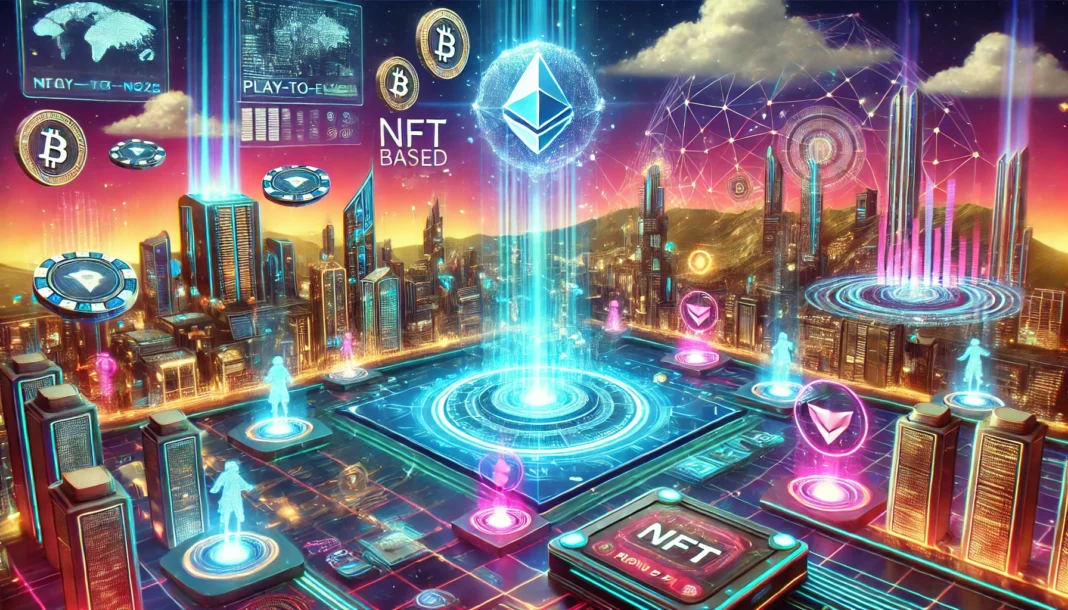Table of Contents
Introduction: The State of Crypto Gaming in 2025
The crypto gaming industry has undergone significant transformation since the early Play-to-Earn (P2E) boom of 2021-2023. What began as an experimental fusion of gaming and decentralized finance (DeFi) has now matured into a sophisticated ecosystem driven by innovation, sustainability, and broader adoption. In 2025, blockchain games are no longer just about earning; they focus on immersive experiences, player ownership, and sustainable in-game economies.
This article explores the evolution of Play-to-Earn models, the rise of Play-to-Own (P2O), the role of artificial intelligence (AI), and how mainstream gaming giants are embracing blockchain technology.
The Evolution of Play-to-Earn: From Hype to Sustainable Models
The early years of Play-to-Earn were marked by skyrocketing valuations, high user engagement, and, unfortunately, economic unsustainability. Games like Axie Infinity and The Sandbox proved that players could earn by participating in blockchain-based ecosystems, but many projects suffered from hyperinflationary tokenomics and unsustainable reward structures.
By 2025, the industry has learned from its mistakes. Modern P2E models are built on:
- Sustainable Tokenomics – Balanced supply and demand mechanisms to avoid inflation.
- Skill-Based Earnings – Rewards are increasingly tied to player skill rather than mere participation.
- Hybrid Monetization – A mix of Free-to-Play (F2P), Play-to-Own, and marketplace transactions ensures a diversified revenue model.
The Role of NFTs and Digital Ownership in Modern Crypto Games
Non-Fungible Tokens (NFTs) continue to play a crucial role in the evolution of crypto gaming. Unlike early speculative NFT assets, today’s in-game NFTs serve practical purposes, such as:
- True Ownership – Players can own, trade, and utilize their digital assets across multiple platforms.
- Soulbound Tokens (SBTs) – Non-tradable NFTs that verify achievements and in-game progress.
- Cross-Game Interoperability – The ability to use assets across multiple blockchain-based games and metaverse environments.
Play-to-Own and Hybrid Earning Models: The Next Generation of GameFi
One of the biggest shifts in 2025 is the transition from Play-to-Earn to Play-to-Own (P2O). Instead of constantly extracting value, players are now incentivized to build and develop within game ecosystems. Key features of P2O include:
- NFT-Based Item Ownership – Items purchased or earned in-game belong permanently to players.
- Creator Economies – Players and developers can co-create game assets, monetize them, and share revenue.
- Reduced Dependence on Token Incentives – The focus is now on in-game utility and engagement rather than token farming.
The Impact of AI and Smart Contracts on Crypto Gaming
AI and blockchain technology have begun working hand-in-hand to enhance gaming experiences. Innovations include:
- AI-Driven NPCs – Smarter, interactive characters that adapt based on player behavior.
- Dynamic In-Game Economies – AI-powered systems that balance supply, demand, and inflation of virtual assets.
- Automated Governance via DAOs – Decentralized decision-making through smart contracts ensures fairer game development and rule enforcement.
Challenges Facing the Play-to-Earn Industry
Despite the progress, challenges remain in scaling crypto gaming:
- Regulatory Uncertainty – Governments continue to develop policies around digital assets, affecting GameFi adoption.
- Blockchain Scalability Issues – High transaction fees and slow processing times remain obstacles, though solutions like Layer 2 networks and sidechains are helping.
- Security Concerns – Hacks and exploits in blockchain gaming still pose a risk, making smart contract auditing essential.
The Role of Major Gaming Studios and Traditional Companies
Mainstream gaming companies have slowly warmed up to blockchain technology. In 2025, major gaming studios like Ubisoft, EA, and Square Enix have integrated blockchain elements into their titles. Key developments include:
- Hybrid Web2 & Web3 Games – Games that allow both traditional and blockchain-based gameplay.
- Blockchain-Backed Digital Marketplaces – Secure, on-chain marketplaces for trading in-game assets.
- Partnerships with Web3 Developers – Traditional gaming studios collaborating with blockchain-native projects.
Crypto Gaming and the Broader Metaverse Vision
The metaverse and crypto gaming are becoming increasingly intertwined. Developments in 2025 include:
- Persistent Virtual Worlds – Fully decentralized environments where players can engage in play, commerce, and social interactions.
- Virtual Real Estate Boom – Ownership and development of virtual spaces continue to grow as part of metaverse gaming.
- Decentralized Social Gaming – Blockchain-based social interactions within gaming ecosystems.
The Future of Play-to-Earn: Trends to Watch in 2025 and Beyond
As we look ahead, key trends shaping the future of crypto gaming include:
- Sustainable Reward Structures – Models that prioritize long-term economic stability over quick gains.
- AI, VR, and Blockchain Integration – Enhanced experiences through cutting-edge technology.
- Decentralized Game Publishing – Games developed and governed by decentralized communities rather than corporations.
The Road Ahead for Crypto Gaming
Crypto gaming in 2025 is no longer about unsustainable rewards but about engaging gameplay, true asset ownership, and fair decentralized governance. As blockchain technology continues to mature, Play-to-Earn models will evolve to become more inclusive, balanced, and player-centric.
For developers, investors, and gamers alike, the future of Web3 gaming is bright—offering new opportunities for financial empowerment, digital creativity, and immersive online experiences.















